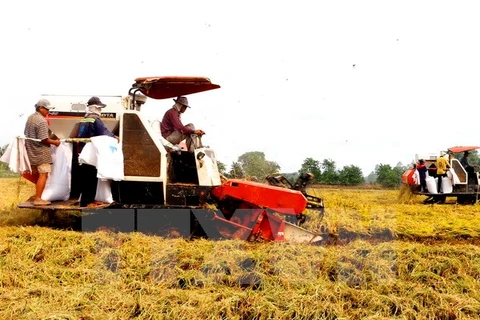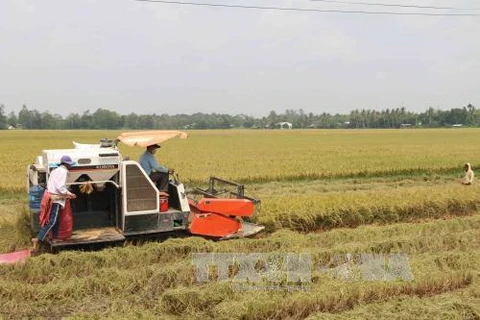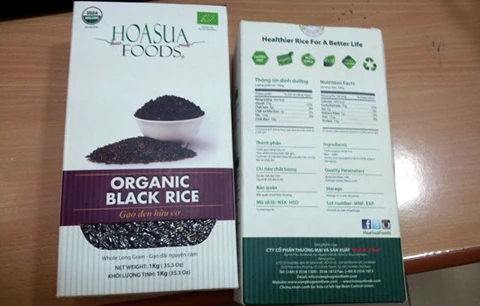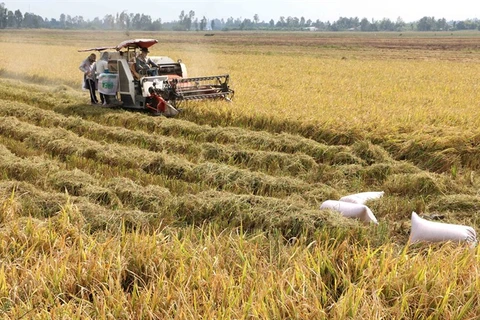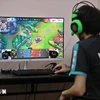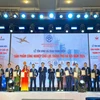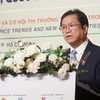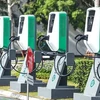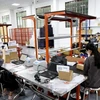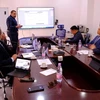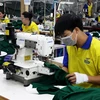 Prime Minister Nguyen Xuan Phuc (front, second, left) visits a rice stall on the sidelines of the conference (Photo: VNA)
Prime Minister Nguyen Xuan Phuc (front, second, left) visits a rice stall on the sidelines of the conference (Photo: VNA) An Giang (VNA) – It’s time to comprehensively reform rice production since the staple plays an irreplaceable role in the country’s agriculture, Prime Minister Nguyen Xuan Phuc emphasized while chairing a conference on March 15 to seek ways to develop the sector sustainably in the Mekong Delta – the rice hub of the country.
The Mekong Delta provides up to 90 percent of Vietnam’s rice export volume thanks to special advantages for agriculture such as flat terrain, fertile soil, and abundant water supply from the Mekong River. Vietnamese rice has been shipped to more than 150 countries with China, the Philippines, Malaysia, and the Ivory Coast as the biggest importers.
An estimated 787,235 tonnes of rice worth over 328 million USD were exported in the first two months of 2017, down 18.5 percent in volume and 21.4 percent in value from a year earlier.
The rice sector is facing a high loss rate and over-15-percent broken accounting for up to 36 percent of export rice, according to reports at the conference in Long Xuyen city of An Giang province.
Other problems in the Mekong Delta include climate change impacts such as drought, sea level rise, and saltwater intrusion, along with changes in the water resources due to economic activities of countries in the upper Mekong River.
Minister of Agriculture and Rural Development Nguyen Xuan Cuong said rice farmers in the region are still poor as they gain the lowest benefits in the rice production chain. Each family that cultivates three rice crops a year earns 35 – 40 million VND (1,530 – 1,750 USD) in profit per hectare, about 2.7 times lower than in Thailand and 1.5 times lower than in Indonesia and the Philippines.
In his speech, PM Phuc said rice plays an irreplaceable role in Vietnam’s agriculture, which forms a pillar of the economy. Agricultural exports brought home over 32 billion USD in 2016. Almost 50 percent of the country’s workforce engages in agricultural activities.
Rice is also one of the strategic agricultural products, giving Vietnam a considerable competitive edge in compared to other rivals.
He said the country needs to strive for topping in terms of rice export revenue in the world. In the next one or two decades, Vietnamese rice should bring about the best added values by satisfying general nutritious and medicinal demand and standards.
He asked for the rice sector to launch a comprehensive reform by breakthrough solutions in terms of policies and development models. He suggested expanding the land ceiling limit for each farming household in an appropriate manner.
Rice farming land must be kept, but the cropping calendar and intercropping must be considered, the Government leader said.
The rice sector also needs to pay more attention to the domestic market of nearly 100 million people to prevent imported rice’s domination, he added.
The PM requested localities and the agriculture ministry to pursue a flexible and wise food security policy. They should encourage private investment in agriculture, expand the land use right, and abolish unnecessary regulations to boost the sector’s development.
They must rely on people and science-technology, not the State, to develop agriculture, he stressed.
The conference targeted that profit for rice growers in commercial rice production areas must account for at least 30 percent of the total revenue. The area of certified rice varieties should make up over 75 percent by 2020 and 100 percent by 2030. Post-harvest loss must be reduced to under 8 percent and the greenhouse gas emissions must be cut down by 10-20 percent from at present.
A notable solution proposed at the event was basing on specific conditions of each area to convert ineffective rice farming land into areas for aquaculture or planting trees with better economic benefits.
During his working trip to An Giang, PM Phuc visited a vegetable and fruit processing line of the An Giang Fruit-Vegetables & Foodstuff Joint Stock Company in Chau Phu distict.-VNA
VNA
